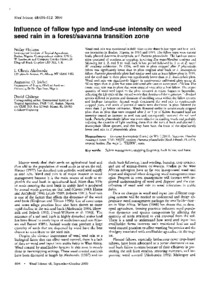| dc.contributor.author | Ekeleme, F. |
| dc.contributor.author | Okezie Akobundu, I. |
| dc.contributor.author | Isichei, A. |
| dc.contributor.author | Chikoye, D. |
| dc.date.accessioned | 2019-12-04T11:21:09Z |
| dc.date.available | 2019-12-04T11:21:09Z |
| dc.date.issued | 2000 |
| dc.identifier.citation | Ekeleme, F., Okezie Akobundu, I., Isichei, A. & Chikoye, D. (2000). Influence of fallow type and land-use intensity on weed seed rain in a forest/savanna transition zone. Weed Science, 48, 604-612. |
| dc.identifier.issn | 0043-1745 |
| dc.identifier.uri | https://hdl.handle.net/20.500.12478/3685 |
| dc.description.abstract | Weed seed rain was monitored in field plots under three fallow types and four land-use intensities in Ibadan, Nigeria, in 1994 and 1995. The fallow types were natural bush, planted Leucaena leucocephala, and Pueraria phaseoloides. The land-use intensities consisted of continuous cropping, involving Zea mays/Manihot esculenta and fallowing for 1, 2, and 3 yr, with each fallow period followed by 1 yr of Z. mays/M. esculenta cultivation. In 1994, seed rain in plots cropped after P. phaseoloides fallow was significantly lower than in plots cropped after bush or L. leucocephala fallow. Pueraria phaseoloides plots had similar seed rain as bush fallow plots in 1995, and the seed rain in these plots was significantly lower than in L. leucocephala plots. Weed seed rain was significantly higher in continuously cultivated plots across all fallow types than in plots that were cultivated after one or more years of fallow. The lowest seed rain was in plots that were cropped once after a 3-yr fallow. The largest quantity of weed seed input in the plots occurred in either August or September, reflecting the life cycle of the annual weeds that dominated the vegetation. Individual species differed in pattern and duration of shedding seeds within the fallow systems and land-use intensities. Annual weeds dominated the seed rain in continuously cropped plots, and seeds of perennial weeds were dominant in plots fallowed for more than 1 yr before cultivation. Weeds flowered earlier in continuously cropped plots than in plots that were cropped after 2 or 3 yr of fallow. Increased land-use intensity caused an increase in seed rain and consequently increased the soil seed bank. Pueraria phaseoloides fallow was more effective in shading weeds and probably reducing the quantity of light reaching them than the natural bush and planted L. leucocephala fallow systems, and this may have been the basis of the significantly lower seed rain in P. phaseoloides plots. |
| dc.language.iso | en |
| dc.subject | Fallow Management |
| dc.subject | Cropping Frequency |
| dc.subject | Bush Fallow |
| dc.subject | Weed Seed |
| dc.subject | Soil Seed Bank |
| dc.subject | Farmers |
| dc.subject | Weed Control |
| dc.title | Influence of fallow type and landuse intensity on weed seed rain in a forest/savanna transition zone |
| dc.type | Journal Article |
| dc.description.version | Peer Review |
| cg.contributor.affiliation | International Institute of Tropical Agriculture |
| cg.contributor.affiliation | Obafemi Awolowo University |
| cg.coverage.region | Africa |
| cg.coverage.region | West Africa |
| cg.coverage.country | Nigeria |
| cg.isijournal | ISI Journal |
| cg.authorship.types | CGIAR and developing country institute |
| cg.iitasubject | Weed |
| cg.iitasubject | Farm Management |
| cg.iitasubject | Livelihoods |
| cg.iitasubject | Plant Production |
| cg.iitasubject | Handling, Transport, Storage And Protection Of Agricultural Products |
| cg.iitasubject | Smallholder Farmers |
| cg.iitasubject | Pests Of Plant |
| cg.iitasubject | Diseases Control |
| cg.iitasubject | Soil Fertility |
| cg.iitasubject | Soil Information |
| cg.iitasubject | Integrated Soil Fertility Management |
| cg.iitasubject | Plant Diseases |
| cg.accessibilitystatus | Limited Access |
| local.dspaceid | 95840 |
| cg.identifier.doi | https://doi.org/10.1614/0043-1745 |

